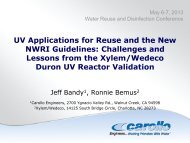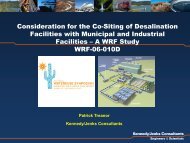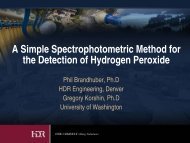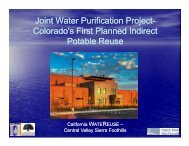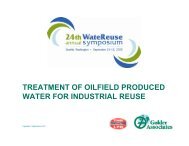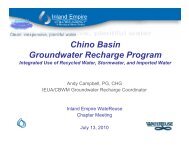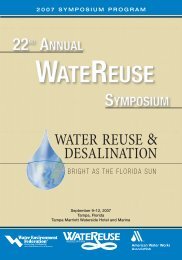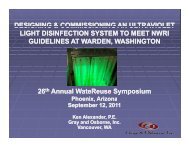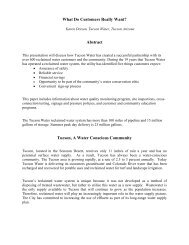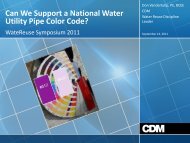Desalination Plant Intakes - WateReuse Association
Desalination Plant Intakes - WateReuse Association
Desalination Plant Intakes - WateReuse Association
You also want an ePaper? Increase the reach of your titles
YUMPU automatically turns print PDFs into web optimized ePapers that Google loves.
and levels of biological productivity comparable to those lost as a result of the intake operations.Coastal wetlands are the nursery areas for many of the species impacted by desalination intakes.Wetland restoration is, therefore, a common mitigation measure for large seawater intakesystems. For example, development of new coastal wetlands is the preferred impingement andentrainment mitigation alternative for the 50 MGD Carlsbad seawater desalination project inCalifornia.The time and cost expenditures involved in the permitting, implementation, maintenance, andmonitoring of such mitigation measures are significant, and such habitat restorative measures aretypically used when the impingement and entrainment reduction measures described in theprevious sections are not readily available or viable for a given project.Some environmental groups do not consider mitigation as an acceptable I&E managementalternative and have challenged the legality of the use of I&E mitigation measures for bothpower plant and desalination plant intakes. Court resolutions to recent legal challengesassociated with the permitting of the 50 MGD Carlsbad and Huntington Beach SWRO projects,however, indicate that mitigation by environmental restoration is a viable method forsupplementing the use of best technologies available and operational measures to address thepotential environmental impacts associated with collecting seawater for desalination.CONCLUDING REMARKSIn summary, appropriately sited, designed, and operated seawater desalination plant intakes canhave minimal environmental impacts on the marine environment and resources. In fact, based onrecent studies, impingement and entrainment resulting from well-planned and designed openocean intakes would be minor: the equivalent of the daily food intake of one pelican and the lossof the annual bio-productivity of five adult female halibut, respectively. Ongoing developmentsin impingement and entrainment reduction technology, combined with the existing wealth ofknowledge and experience in this field, both domestically and internationally, pave the way formaintaining sustainable and environmentally safe production of fresh water from the ocean. Withover 20 years of successful operational experience at more than 8000 desalination plantsworldwide, seawater desalination is currently a well-established drinking water productiontechnology of proven performance which will play an increasingly prominent role in wellbalanced and sustainable water supply portfolios of coastal communities in the US and abroad.Seawater <strong>Desalination</strong> <strong>Plant</strong> <strong>Intakes</strong> – Impingement and Entrainment Page 21




